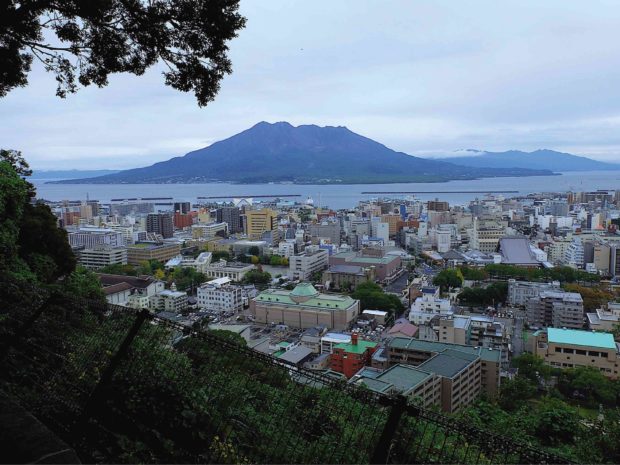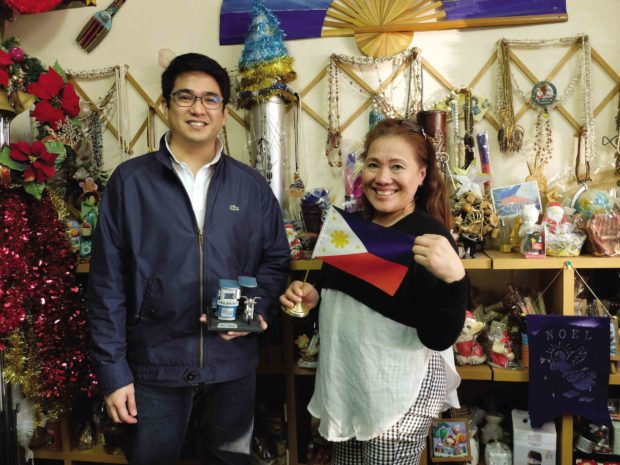Kagoshima: Home is where the heart is

FAMOUS TOURIST SPOT The seaside city of Kagoshima overlooks its most famous tourist spot, the active volcano of Sakurajima.
“How did you learn about Kagoshima?” Bro. Lawrence Aikee Esmeli asked. “I’m surprised you found out about Kagoshima. Usually, tourists would go to the famous prefectures.”
Bro. Aikee is a teacher in the seaside city of Kagoshima in Japan. The campus is overlooking the city’s most famous spot, the active volcano of Sakurajima. He teaches mostly Japanese high school boys.
La Salle Gakuen is one of the only two La Salle schools in Japan. The other one is found in Hakodate, Hokkaido.
Kagoshima, while too far from Japan’s more popular tourist spots, is not as remote as many people think.
The Kagoshima-Chuo station, the gateway to the prefecture, is situated inside a mall that offers luxury goods and restaurants.
Located in the southwestern tip of the island of Kyushu, Kagoshima has a relatively warm climate and hardly experiences snowfall.
Kagoshima has an airport but there is no airline from the Philippines that offers direct flights.
The main entry point for Filipinos is through Fukuoka, more than 280 kilometers from Kagoshima.
It would take roughly three hours via Japan’s Shinkansen (bullet train) and would cost around 10,000 yen, or P5,000.
Calling
The city is a magnet for history buffs. Kagoshima may not be as popular as Tokyo or Kyoto, but it has a significant role in the history of Japan.
The relatively laid-back city is the location of the Satsuma Rebellion that attempted to bring down the government in 1877. Saigo Takamori, considered to be the last samurai, fell in Mt. Shiroyama.
Three full days are not enough to explore historic sites such as Mt. Shiroyama, Sengan-en and Chiran Samurai Residence, among others.
Bro. Aikee agreed to the assignment at La Salle Gakuen when his superior presented it to him after his teaching mission at St. Jaime Hilario Integrated School-La Salle ended. Prior to that, he was assigned at De La Salle Lipa.
“Our religious superior gave me the option and I thought that coming here could respond to a greater need,” he said. “I wanted to fill the needs of our new ‘brother countries’ in trying to sustain the vitality of our mission, especially in countries where Catholics are a minority.”
Bro. Aikee recalled his first day teaching Japanese high school boys. “I was really nervous,” he said. “I have taught for more than six years in the Philippines but it seemed like I was a new teacher again. Everything was a gamble but I survived nonetheless.”
These days, Bro. Aikee and his colleagues start the day praying and “serving [through our involvement in the school] as a community of brothers. It’s a daily response to our ‘calling,’” he said.
Bro. Aikee decided to take his vows as a De La Salle brother in the Philippines upon realizing that “I wanted to help people.” He could have become the priest who celebrated Mass and performed holy sacraments but his knack for community organizing and keen sense of empathy for the marginalized steered him toward another path.
“My parents are [naturally] kind people and I witnessed that kindness toward others while growing up,” he said. This youngest of three siblings took up International Studies at De La Salle University and hails from Pasig City.
Samahan ng mga Pilipino sa Kagoshima
In his first few days in Kagoshima, Bro. Aikee wondered if there were Filipinos in the area. It took a couple of weeks more to get an answer. A colleague introduced her to Mary Hira (Maria Corazon Ojinonan), a Filipino who has called Kagoshima her home for 25 years after marrying Koji, whom she met while working as an entertainer. Their sons are Tomohide (Mark Stephen) and Masayoshi (Mark Anthony).

PROUD PINOYS Bro. Aikee and Mary Hira have found a home in Kagoshima but still seek fellow Pinoys for companionship.
Perhaps it is her being the eldest of 12 siblings that made Mary more caring and nurturing toward compatriots in Kagoshima. This Surigao del Sur native helped establish Samahan ng mga Pilipino sa Kagoshima (SPK) with other Filipinos.
“It was around 20 years ago when we realized that it was difficult to secure official documents such as passports if you are not a member of an association here,” Mary said.
More than 800 km separate Kagoshima from Osaka, where passports are processed. Mary said they were lucky that representatives from Osaka had recognized the need of those in Kagoshima and visited the city regularly for passport renewals rather than have Filipinos go there and spend quite a lot in train fare.
To make it easier for Filipinos to meet, as well as to augment her income, Mary put up a sari-sari store in Kagoshima City, an hour away from her husband’s hometown of Hioki. Her store is filled with products from the Philippines, including food, toiletries and costumes for cultural performances. Nurses often refer to her Filipinos admitted to the hospital who need assistance.
When her husband fell ill a few years ago, their eldest son started helping out in household expenses. Mary also took a morning job in the maintenance department of a hospital in Kagoshima to augment the family income. She tends to her store in the afternoon.
Mary admitted that she no longer sees herself settling back in the Philippines. It’s not only because her sons are half-Japanese, but also because she feels life is better here compared to her home country. But she visits her family every so often.
Single mother in a foreign land
Ma. Victoria Lazaro is one of the Filipinos who regularly hear Mass at St. Francis Xavier Cathedral. She takes an hour to travel from the town of Hioki to the city.
A Japanese priest, who speaks Tagalog well and has been to the Philippines, celebrates an English Mass at 3 p.m. for Filipinos.
It also serves as a sort of gathering for these expatriates to catch up because many of them live a bit too far apart from each other.
Victoria is raising her three kids — two boys and a girl — single-handedly. She started working as an entertainer in Shimane-ken in 1998 when she was 26, and in 2003, she started working in Kagoshima where she met her former husband, a tea farmer in Hioki.
When Victoria separated from her husband in 2010, a fellow Filipino helped her find work to support her kids.
“The Filipino friends I made here are very supportive during trying times,” she said. “I’m grateful to them when they help look after my kids so I could go to work at night.”
During the holidays, Victoria fulfilled her lifelong dream of taking her children to Tokyo Disneyland.
Also a member of SPK, she realized that while there were not that many Filipinos in Kagoshima, most of them tried to help their kababayan even with personal problems.
Like Mary, Victoria feels that Kagoshima is where home is even if she sometimes longs for the family she had left behind in the Philippines. But she is fortunate to have met friends even in this foreign country. She also takes comfort in the presence of a community of Filipinos to whom she could seek help when needed.
Even if Victoria is now based in Japan, she makes sure to introduce Filipino culture to her children. A good start is taking them to hear Mass and cooking Filipino food for them.
Challenges
In his two years in Kagoshima, Bro. Aikee saw that Filipinos here did not have good access to social and legal protection compared to those living in the big cities of Tokyo or Osaka, where most nongovernment organizations held offices.
“Here, they would have to rely on the experience of Filipinos who have been here long enough,” he said. “Because of the language and culture, Filipinos have a hard time understanding rules and restrictions, especially when they are in a difficult situation. They’d be lucky if they find a generous fellow Filipino who, in his/her individual capacity, would leave work and spend personal time to help them. At best, the little gestures of pakikipagdamayan and pakikisama go a very long way through tough times.”
Some members of SPK perform during special occasions or Filipino holiday gatherings. Philippine Independence Day is one they try to observe every year. They also organize Christmas parties despite their limited number.
While not all Filipinos living in Kagoshima are members of SPK, this does not deter them from helping each other should the need arise.
Bro. Aikee sometimes spends his Sundays with other Filipinos and joins the planned activities that they usually announce through social media channels.
“I try my best to participate in the activities,” Bro. Aikee said.
The Filipinos here are happy to welcome visiting fellow Pinoys, often asking what compelled these guests to visit this “almost unheard-of” tourist destination in Japan.
But Kagoshima has its own charm. While it is considered a remote area, it has the many amenities and conveniences that bigger cities in Japan offer.
But it helps for tourists and expats to have a basic knowledge of the Japanese language because, unlike in other cities, there are not too many English translations of signs and important notices in Kagoshima.
Not many locals speak English, and it would be embarrassing to be offered hospitality or kindness by the locals, only to respond to their attempts at small talk with a shy smile.














